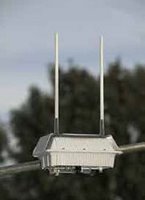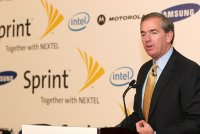 Due out in October 2006, the Tropos® Networks' Tropos 5320 combines 802.11a and 802.11b/g radios with the MetroMesh OS to create mesh networks. As expected, while servicing client nodes these points can bridge with each other over the air doing away with the need of dedicated hardware uplinks. The new twist is that they can dynamically shift between 5 GHz and 2.4 GHz spectrums to accomodate local conditions and new models promised to "quickly follow" the 5320 will add "...MIMO, WiMAX, 4.9 GHz, 3G/4G cellular and other unlicensed and licensed radio technologies" to its multi-radio capability.
Due out in October 2006, the Tropos® Networks' Tropos 5320 combines 802.11a and 802.11b/g radios with the MetroMesh OS to create mesh networks. As expected, while servicing client nodes these points can bridge with each other over the air doing away with the need of dedicated hardware uplinks. The new twist is that they can dynamically shift between 5 GHz and 2.4 GHz spectrums to accomodate local conditions and new models promised to "quickly follow" the 5320 will add "...MIMO, WiMAX, 4.9 GHz, 3G/4G cellular and other unlicensed and licensed radio technologies" to its multi-radio capability.
It's easy to see how WiMAX, for example, could help tie a router into the "wireless backbone" at the fringes of a metro area, and reach the targeted market--dialup Internet users--with comfortably backward compatible 802.11b WiFi. I don't think the typical dialup Internet user in 2006 has a MIMO router at home and a 3G phone at their side. As for 4G, I don't imagine we'll see that model out much before the infrastructure for a 4G network appears!
Q. Where have you connected to a mesh network?
Photo source of Tropos 5210 router: Tropos Networks.
Friday, August 18, 2006
Tropos 5320 MetroMesh Introduces Multi-band Mesh
Posted by
James D. McNamara, PMP
at
11:00 PM
0
comments
![]()
Labels: MAN, mesh networks, Tropos Networks, WiMAX
Friday, August 11, 2006
Sprint Nextel Announces 4G Wireless Broadband Initiative with Intel, Motorola and Samsung
 Sprint Nextel Corporation [S] announced it will deploy WiMax as its 4G technology platform across its network, with first availability in Q4 2007. While IEEE 802.16 has been an evolving technology, commercial deployments for mobile connectivity - as opposed to last-mile, fixed wireless connections - are definately on the bleeding edge of progress. Sprint Nextel is deploying IEEE 802.16e-2005 in the 2.5GHz spectrum. It has enlisted Intel, Motorola and Samsung to make chipsets available; the end user devices will have to be developed in tandem with the network.
Sprint Nextel Corporation [S] announced it will deploy WiMax as its 4G technology platform across its network, with first availability in Q4 2007. While IEEE 802.16 has been an evolving technology, commercial deployments for mobile connectivity - as opposed to last-mile, fixed wireless connections - are definately on the bleeding edge of progress. Sprint Nextel is deploying IEEE 802.16e-2005 in the 2.5GHz spectrum. It has enlisted Intel, Motorola and Samsung to make chipsets available; the end user devices will have to be developed in tandem with the network.
WiMax is fast, and its large cells are suited for blanketing metropolitan areas. But this stuff is new, which means expensive. The technology requires lots of new infrastructure on top of the merged Sprint and Nextel's existing network, and the company will spend up to $3B in 2007 and 2008 rolling it out to a predicted footprint of 100 million people. This is a large investment in an unproved market, but Sprint Nextel hopes to capitalize by being the first operator to enter it. They predict the user cost will be lower, however, assuming a critical mass adopts it.
For more information on WiMax, check out the WiMax Forum, the industry body that promotes IEEE 802.16 and ETSI HiperMAN standards. From their site:In a typical cell radius deployment of three to ten kilometers, WiMAX Forum Certified™ systems can be expected to deliver capacity of up to 40 Mbps per channel, for fixed and portable access applications. This is enough bandwidth to simultaneously support hundreds of businesses with T-1 speed connectivity and thousands of residences with DSL speed connectivity. Mobile network deployments are expected to provide up to 15 Mbps of capacity within a typical cell radius deployment of up to three kilometers.
Q. Will WiMAX live up to its promise being a fast and affordable Worldwide Interoperability for Microwave Access?
Photo source: Sprint Nextel. Sprint Nextel President and CEO Gary Forsee giving presentation.
Posted by
James D. McNamara, PMP
at
9:00 PM
0
comments
![]()
Labels: Sprint Nextel, WiMAX
Friday, August 04, 2006
Fastap appears in LG AX490 Flip Phone
 After seeing Digit Wireless announce the Fastap keyboard announced a couple of years ago, I was delighted to see it recently enter the US market, as an OEM component in the featured and affordable LG AX490. The Fastap keyboard features raised buttons at the junctions of the number keys, essentially cramming a full alphanumeric keyset on the space normally reserved for the cannonical 10, hash and splat.
After seeing Digit Wireless announce the Fastap keyboard announced a couple of years ago, I was delighted to see it recently enter the US market, as an OEM component in the featured and affordable LG AX490. The Fastap keyboard features raised buttons at the junctions of the number keys, essentially cramming a full alphanumeric keyset on the space normally reserved for the cannonical 10, hash and splat.
I currently use a Blackberry QWERTY thumboard to compose e-mail and send the occassional SMS while I'm away from my desk. In fact I find it more convenient to pen a paragraph poolside than bother retreating indoors to use a 64-bit electricity sink (with 101-key keyboard) to do the same, at a net loss of time. Still, tapping out the 7 key a full seven times to achieve a capital S is a non-starter for me, especially when I need a fully-functional Backspace key to accomplish anything marginally resembling correct spelling. (Before you ask about iTap, you should know I'm a lost cause. My fingers have known nothing but QWERTY since we had a leased rotary dial phone in the kitchen.) Even the introduction of the sleeker 7100 series, which looks like more phone than PDA, combines up to two alphas per key, gave me pause. Thank goodness the 8700 series retained a keyboard better suited for thumbs trained on rotary dialing.
That being said, a full thumboard seems synonymous with "more PDA than phone" profiles. One's arms can get tired on a long phone call. I'm anxious to get my hands on an LG AX490 and see if it works for me.
Q. Does the Fastap keyboard work for you?
Photo source: Digit Wireless
Posted by
James D. McNamara, PMP
at
11:00 PM
0
comments
![]()
Labels: Blackberry, Digit Wireless, Fastap